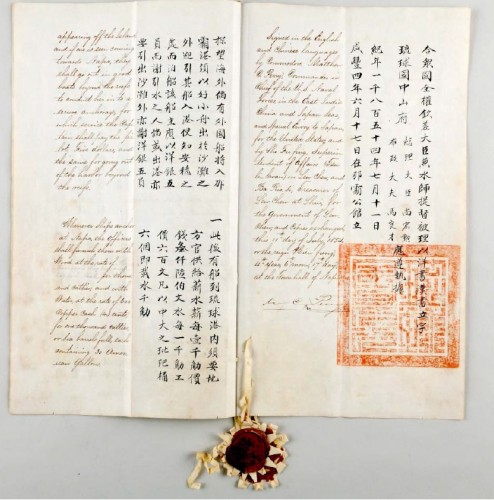Ryukyu’s International Treaties return to Okinawa after 141 years

An original document of the Ryukyu-U.S Treaty of Amity signed by the Ryukyu Kingdom and the United States in 1854. (The Ministry of Foreign Affairs Diplomatic Archives Collection).
February 4, 2015 Tsuyoshi Arakaki of Ryukyu Shimpo
On February 27, the Urasoe City Museum exhibits three original copies of the Ryukyu Kingdom’s treaties of amity signed with the United States in 1854, with France in 1855, and with the Netherlands in 1859. These original copies were confiscated by the Meiji Government in May 1974 and held by the Ministry of Foreign Affairs. These original documents have crossed the ocean and will be exhibited in Okinawa for the first time in 141 years. International law specialists note that these original documents are evidence of Ryukyu’s sovereignty at that time under international law. In the midst of growing awareness of and requests for Okinawa’s rights to self-determination, especially regarding the U.S. military base issues, the homecoming of these treaties could influence discussions over Okinawa’s restoration of sovereignty.
The Ryukyu-U.S Treaty of Amity was signed with Commodore Perry, who came to Uraga (Kanagawa Prefecture) and the Ryukyu islands to pry open Japan, which had an isolationist policy at the time. Because of its bias towards the US, which offered special privileges such as providing water and firewood provision to the U.S ships and their consular jurisdiction, the Ryukyu government initially rejected the treaty. However, the kingdom eventually yielded to pressure from Commodore Perry and signed the treaty. The Ryukyu government later signed similar treaties with France and Holland.
Planning to annex the Ryukyu Kingdom and to deprive Ryukyu of its diplomacy after the Meiji restoration, the Meiji government ordered the kingdom to submit three treaties in March 1973. Although Ryukyu persistently resisted, they yielded to the tough stance of the Japanese government in the end. In May 1974, Chihwanuku Ueekata Shiishii went to Tokyo with three treaties and turned them over to the government. Currently, the Ministry of Foreign Affairs Diplomatic Archives possesses the original documents.
During the process of annexation by Japan, which is known as the Ryukyu disposal, the Ryukyu Kingdom claimed their sovereignty by signing these international treaties and presented them as a form of resistance to avoid annexation by the Meiji government.
Professor Hideaki Uemura of Keisei University and Professor Hiroyuki Abe of Kanagawa University pointed out that the Ryukyu was an independent actor under international law, not a part of Japan. The Meiji government besieged the Shuri Castle with its military and police and pressured King Sho Tai to agree on the establishment of Okinawa Prefecture. Pointing out that this action by the Meiji government amounts to “compulsion to representatives of a nation,” which the customary international law of the time prohibited, Uemura and Abe claim the annexation is illegal under international law.
The original copies of three treaties will be displayed at “the Okinawa Special Exhibition: the Ryukyu, the End of Edo, and the Meiji Restoration” at Urasoe City Museum from February 27 to March 29. The exhibit is sponsored by the Ryukyu Shimpo and the Cooperative Association Okinawa Industrial Project.
(English translation by T&CT and Megumi Chibana)
Previous Article:Symposium on right to self-determination for Ainu and Ryukyuan
Next Article:Okinawa Governor Onaga officially requests moving Futenma Air Station outside Okinawa
[Similar Articles]
- US shows a copy of the Ryukyu-US Treaty and letters by Commodore Perry
- [Editorial]Treaties show that Japan’s annexation of the Ryukyu Kingdom was an unjustified act
- ACSILs demands an apology for annexation of Ryukyu, calling it a “Violation of International Law”
- Report submitted to UN requesting return of Ryukyuan remains
- Ryukyu Disposition Symposium: the 140 years since colonialism
 Webcam(Kokusai Street)
Webcam(Kokusai Street)


